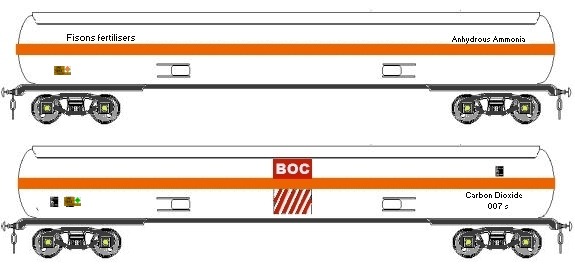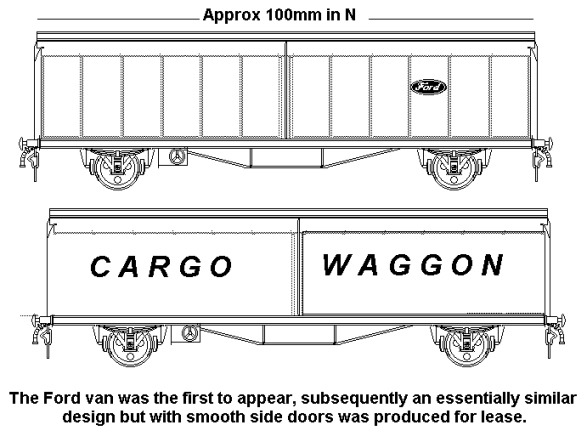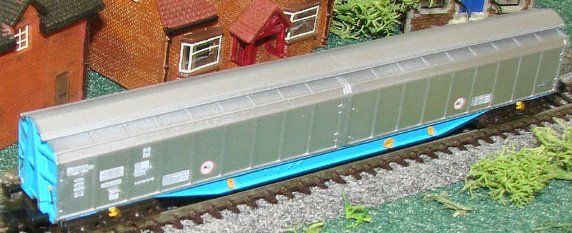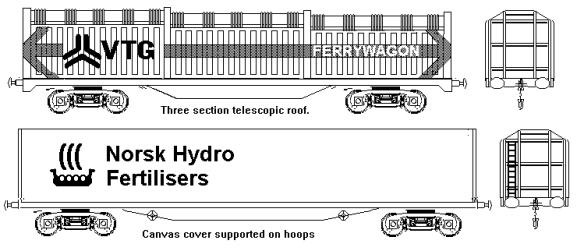Following nationalisation British Railways built and leased rolling stock to private owners. The first were probably some chemical tank wagons built in 1951 and leased to Petrochemicals Ltd. In 1952 these tanks were amongst the first gas tanks to receive a secondary 'sun shield' added to the top of the tank. Leasing stock was never terribly important business to British Rail however and from the 1960's British Railways was discouraged from capital investment by Government policy. They then encouraged firms to buy or lease wagons for more specialised traffic from the firms specialising in this trade. Most modern private owner stock came from a few large firms operating in the UK and also in the form of wagons from the continent brought over on the train ferries and more recently via the channel tunnel. By the middle of the 1980's something like 50% of the traffic on the railways was being moved in private owner or leased rolling stock.
Two major British wagon hiring companies built their own wagons, Railease (a division of the Standard Railway Wagon Co., renamed Standard Railfreight in about 1983 and bought by Procor in 1971), and Procor (a division of the Canadian Bombardier Inc established in 1970 and renamed Bombardier Prorail in 1990). Other firms such as Naaco/Tiger Railcar, Storage & Transport Systems (part of the Belgian CAIB group) and Traffic Services Ltd. (which started life as Petrochemicals Ltd. in the 1950's) all buy or lease rolling stock and offer other shipping services to their customers.
The end of the Speedlink wagon load services in 1991 hit this side of the industry hard, the reintroduction of wagon load freight under the Enterprise banner in 1993 did little to help and I am not aware of any of these companies being still in business after about 1995. Most of their stock was, I believe, purchased by EWS, who do not have to contend with government reluctance to invest and I understand that EWS feels it to be more profitable to provide the rolling stock as well as the locomotives to its customers.
The Peco `Grano' is a good example of the leased wagon, introduced in 1965, the first batch was built by by Pressed Steel Co. for a company called BRT (British Railway Traffic & Electric Company, formed in 1907 and bought by Procor in 1974). These were originally painted in a standard overall dark blue with the BRT logo on a small plate to the lower left or lower right. They were leased to the Scottish National Distillers Company who used them to carry grain from East Anglia to their Scottish distilleries. The SND added colourful hoardings on the sides of some wagons, advertising the brands of whisky they produced. In 1983 the SND bought their own fleet of larger Polybulk wagons but Procor overhauled and re-sprung the old 'blues', fitting them with air brakes to allow higher speeds. They were then leased to a company called Traffic Services Limited (TSL) who used the wagons for their Grainflow fleet alongside some larger French built Polybulks (discussed below). Grainflow was actually a total distribution package offered by TSL, the wagons were painted in a green and grey livery with yellow lettering and were moved in Speedlink trains. Curiously the re-vamped old grain wagons still had the BRT logo on the small plate mounted toward one end although the company was by this time called Procor.
The former BRT was for a time part of the giant United Dominions Trust, giving it links with various firms such as Alcan the aluminium people. Research undertaken with Alcan produced the first aluminium bodied tankers in the 1960's but the idea did not catch on until the 1970's, by which time BRT had been sold off to Procor. The original vacuum braked aluminium bodied Cemflow wagons had a cylindrical tank with hopper type cut-aways in the lower part of each end. They carried about a third again as much cargo as the British Rail Presflo of the early 1950's but the all-up gross loaded weight was slightly less. These early vacuum braked wagons remained in service until the end of 1996.
The curious 'sagged' or 'depressed centre' tank available in the Graham Farish range is an aluminium bodied design introduced by Procor (who called it the Cemflo) in about 1970. This soon became the most popular type for cement and some other powders and has remained so into the early 1990's. This depressed centre tank wagon is available as an accurate ready to run model from Graham Farish. A metal body kit of the type for a Peco chassis is available from Fleetline but this is less satisfactory as it is inaccurate and tends to be top-heavy. The original tank design used simple gravity discharge but later versions have air-fluidisation as well. Tiger Rail is the largest operator of the depressed-centre aluminium bodied air-fluidised powder carrying wagons and these are the most popular type for cement traffic. In the 1970's Blue Circle invested heavily in 102 ton GLW wagons with two separate depressed centre aluminium tanks on a single bogie chassis. The tanks on these vehicles were plagued with cracks and by the 1980's they had switched back to two axle designs for new vehicles. The bogie vehicles were coded PDA and they remained in service into the late 1980's and possibly the early 1990's.
In the pre war period, and up to the early 1970's, there was not a great deal of traffic in crushed stone, most demand for this 'aggregate' was met from local gravel quarries. In the 1960's about two million tons of aggregate were moved annually, mainly in British Rail owned mineral wagons. The motorway building boom of the 1970's boosted demand and by the 1980's this traffic had increased to eleven million tons. Procor designed and built large numbers of fifty ton PGA hoppers to cater for this traffic, models of which are available from Graham Farish.
There was also a covered version of the PGA, a model of which is available from Graham Farish, which was used for a range of powder and fine granular products. Some of these were used for sand and carried British Industrial Sand livery (Bernard Taylor offers a BIS detailing kit for the Farish model). Some of the old British Railways covhop wagons (built in the 1950s) were air-piped and were occasionally seen mixed in with the new air braked hopper wagons in the later 1970s and early 1980s.
British Steel built a fleet of 102 GLW (tons Gross Loaded Weight) bogie tipplers for use feeding their works with imported ore (which contains more iron than the domestic product). They ran to Llanwern in South Wales from Port Talbot, to Scunthorpe from Immingham and to Ravenscraig near Glasgow from the Clyde. Some also supplied the BSC works at Tees Side and when this plant closed (in the late 1970's I believe) some of these wagons were sold to Procor (a wagon building and leasing firm) who reconditioned them and leased them to Foster Yeoman for stone traffic in 1981. Taylor Plastic Models have now released a kit of the type. These wagons were augmented in the later 1970's by longer lower wagons of a broadly similar design. In N the Lima 'London Brick' tippler wagon can be repainted to represent these later wagons.
Fig___ BSC tippler wagon
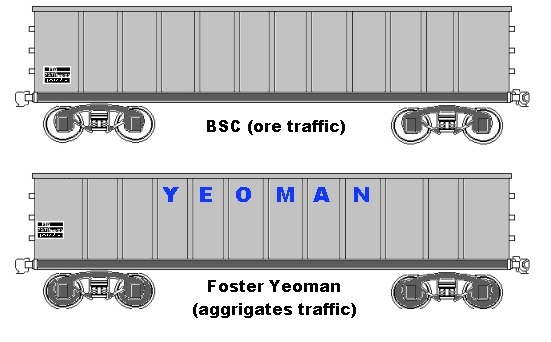
British Steel painted the wagons light grey with black chassis, I believe the Yeoman wagons were painted light grey with Yeoman in blue as shown and a black chassis.
Steel scrap, iron ore and large billets of steel are all regular cargoes for which the private sector has catered. British Rail had some re-bodied former 21 ton mineral wagons which they used for scrap traffic, these were essentially similar to the 21 tonner but had only a single door on each side.
BR built two prototypes of high bodied scrap carrying wagons, diverting two chassis from the HBA building program, fitting a high steel body and coding them MFA. These wagons were amongst the first to feature a heavily ribbed 'tippler' type body with five heavy posts on each side. These two wagons were intended to show the industry the sort of vehicle BR thought would serve well for the work, they resembled a re-bodied mineral wagon in having a single side door but the body itself was nearly eight feet high (about seven feet eight inches I believe) so an access ladder was added at one end. Railease, the leasing subsidiary of Standard Railway Wagon Co. marketed a prototype air braked POA four wheeler scrap vehicle in 1978, very similar to the BR built wagons, but little interest was shown at first. The final development of this vehicle, coded PNA under TOPS appeared in 1983, based on the HAA merry go round hopper wagon chassis. By this time the leasing arm of the company had changed its name from Railease to Standard Railfreight. A kit of the PNA is available from Taylor Plastic Models. The design proved a success and British Rail rebodied some redundant chassis with essentially similar bodies, coding these SSA under TOPS. The POAs were progressively re-bodied from about 1987 with a modified body design as the older vehicles started to suffer from rust and loading/unloading damage in use. See also Freight Operations - Steel for further information and a drawing.
All the POA/PNA wagons were sold to BR in 1990 who recoded them SSA and ran them with their own SSA wagons. They then passed to EWS, who repainted them in their house colours of maroon and yellow.
Sheerness Steel in Kent commissioned some 102 ton GLW bogie wagons from Procor (a wagon building and leasing company) to carry both scrap metal and finished steel to and from their works, again making use of Speedlink services. (I believe the Sheerness works closed in 2002, part of the collapse of Allied Steel and Wire)
See also Freight Operations - Steel for further information on scrap wagons including drawings.
One of the first companies to make regular use of the all air braked Speedlink services was Campbell's Soups. BRT the wagon leasing company converted some redundant VDA vans in the early 1970's, fitting them with sides made up of four quarter length sliding doors (the central pair being set out to clear the end pair). These vans were painted plain blue (there is a photograph on Paul Bartlett's website showing one of these early vans, see App 7 Useful Websites). Some of these were re-converted in 1981 by fitting them with curtain sides bearing their logo. See Freight Operations - Private Owner Stock - Overview for an illustration showing the livery. These distinctive curtain sided vans are available in N as an etched brass kit from John Grey (see Available Models section for details). I believe Pedigree foods had a similar rake of curtain sided vans which ran as a block train but I was not able to find the only illustration I have so I was not able to attempt a sketch.
I believe Pedigree Foods had at least one similar curtain sided van bearing their logo in the later 1970's, in the mid 1980's they used a fleet of bogie container flat wagons (built by Charter Rail) to carry thirty foot long 'swap bodies' but I am told these were 'plain bauxite' and did not carry the logo (I am still chasing information on the Pedigree foods stock). See Freight Operations - PO Wagons for more information on these traffics.
Up to the early 1990's Redland Tile was the largest rail connected concrete products firm. They opened for business in 1919 as the Redhill Tile Company, producing concrete roofing tiles at Reigate in Surrey. By 1939 the concrete roof tile was well established with a 22 percent market share and Redhill had additional works in Yorkshire and Leicestershire. After the Second World War Redhill began a programme of acquiring smaller firms and by 1948 the name had changed to Redland. In 1955 the firm acquired the Bursledon Brick Company and a concrete pipe manufacturing firm (subsequently sold off in 1981). In 1981 Redland merged with Cawoods aggregate business and the two firms were consolidated under the Redland banner. In 1995 Redland moved into the general aggregates (broken stone) business, buying a major stake in Ennemix, in the same year it sold its china clay operation in Cornwall to ECC. In 1996 Redland sold their brick making business to Ibstock for £160m, giving Ibstock a 35% of the British market. Also in 1996 Redland sold its European tile making business to its German subsidiary (Braas) but continued to trade under the Redland name in the UK. In 1998, Redland Roofing Systems became a member of Lafarge Roofing, the world's largest dedicated roofing products manufacturer.
Throughout the 1980's Redland was a regular user of rail transport, employing five types of wagon. Three of these were open designs some of which were painted in company livery; twelve Procor PNA bogie drop-side, sixteen Procor PFA standard wagons and fifteen British Railways OAA wagons. Some of the OAA wagons had clip-on raised ends fitted to increase their height and allow a second layer of pallets to be carried. Redland open wagons operating in the North East were reported in two-tone green in 1985 but when I enquired in 1988 the firm advised me that the official body colour was a light grey. The company livery consisted of the name Redland (only the R is capitalised) to the upper left on the 4 wheel stock and in both the upper right and left corners of the bogie stock, the lettering being about 16 inches high. Other markings such as the word FRAGILE (5 inches high) and NOT TO BE LOOSE OR HUMP SHUNTED (3 inches high) are in black on a yellow rectangle, the TOPS markings are in white on a black ground. Brake wheels are white and the roller bearing axle boxes are painted yellow.
The majority of the product (roofing tiles) was strap banded and carried in open wagons. The cargo was packed in with old motor car tyres which often show above the load.
In the 1980's they also shipped pallets in a fleet of covered stock comprising eight IPB large bogie vans leased from VTG and fourteen British Rail VDA vans, as far as I am aware these remained in their owners colours. All six Redland depots (Acton NW London, Gateshead near Newcastle, Cardiff, Southampton, Dewsbury and Hull) were rail connected. Raw materials were supplied (some by rail) from works at Leighton Buzzard, Lutterworth, Tiverton, Stirling, Swaffham and Stanton.
A company called Plasmor use power station ash to mixed with concrete to lightweight blocks which are used for building construction. In 1987 Plasmor began using rail to move their product and the savings in transportation costs allowed them to break into the lucrative London building market. The blocks are light grey in colour, about a foot wide, eighteen inches long and six inches thick (30cm x 45cm x 15cm), they are banded together to form oblongs about four foot high, four foot long and two foot six wide (120cm x 120cm x 75cm). They were shipped from the Plasmor depot near Doncaster on OBA wagons which were fitted with raised end extensions to allow double stacking. Railfreight Construction sector was responsible for the delivery of empty wagons to the depot and the collection of loaded wagons which were hauled (usually by a Class 31) to the Speedlink yard at Doncaster. Here the wagons were sorted into their respective Speedlink trains for delivery.
Fig ___ British Rail wagons in Redland & Plasmoor liveries
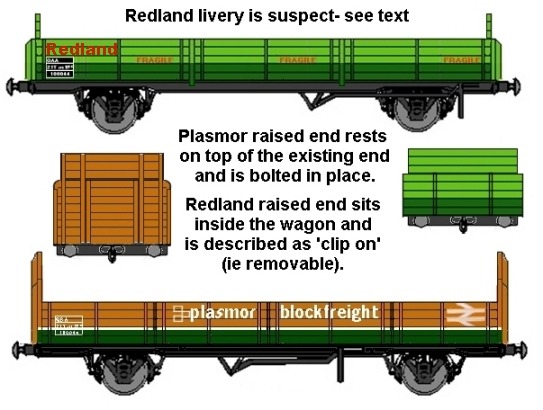
Following the merger with Redland in 1981 Cawoods retained the fuel distribution side under their own banner and, at least up to 2001 they were major operators of coal container services. Cawoods use yellow containers with the firms name in black either vertically on the left hand end or in large letters centrally on the sides. These coal container services are fully discussed in the section on Freight Operations - Coal.
Wet china clay 'slurry' was first supplied to users in 1965, the tankers used are reserved for this trade to eliminate the danger of contamination. Two principal tank wagon types used for slurry are the bogie TBA wagons (rather similar to the Lima Amoco/Milk tank wagon) at 80 ton GLW carrying a load of some 60 tons, and 2 axle wagons carrying about 32 tons with a GLW of 45 tons. English China Clays (ECC) have used a number of interesting tank wagons to carry china clay slurry from Cornwall up to Scotland. In 1987 some unusual wagons were built for this traffic consisting of tanks from redundant forty six ton GLW TTB two axle wagons mounted on redundant bogie chassis from one hundred and two ton GLW TEA tank wagons. The result was a 92 GLW tank wagon coded TCA under TOPS. More recently Naaco have supplied a number of large bogie tank wagons for this traffic, these have a single depressed centre tank mounted on a bogie chassis. These wagons are fully equipped for continental working, the tank is silver with the ECC logo toward the right hand end, the chassis is black and they feature the large black 'data plate' on the left hand end of the chassis (see Livery for full details of these plates).
For the bulk shipment of dry china clay in the 1980's English China Clays employed the Tiger Rail 55 wagons, coded PBA these are 80 ton GLW bogie hoppers for which there are no commercially available models at present.
International rail traffic in china clay, principally to Switzerland, also employs the TSL (Traffic Services Ltd.) bogie Polybulk wagons (similar to the Polybulk grain wagon kit produced by the N Gauge Society). More recently Naaco have supplied ECC with some large bogie depressed centre tanks for this traffic, these wagons are equipped for international operation via the Channel Tunnel.
In 1968 a fleet of bogie curtain sided vans were built for fertiliser traffic, operated by BRT they were leased to Shellstar for fertiliser traffic. The curtain sides proved unsatisfactory as if the load moved they bulged outward making the vehicle out of gauge so in (I think) the mid 1970's they had new sides fitted with pairs of double doors. The curtain sides made adding markings difficult and the vans were fitted with a rectangular plate on the left hand end (bolted to the triangular end support) to carry the TOPS markings. Under TOPS they were coded PWA (later I believe this became JWA). Inside there were partitions between each pair of doors so the van could move part-loaded without the pallets of bagged fertiliser sliding about. I am not sure who Shellstar were but by the 1980's the vans wore UKF livery as shown below. The sketch is based on an example seen at the Rocket 150 exhibition in Manchester in (I think) 1982 but these vans actually carried a number of liveries over the years. Paul Bartlett's web site (see App 7 Useful Links) has a selection of photographs showing those from the later 1970's to the 90's. UKF were taken over by Kemira (a Finnish chemical and fertiliser company) in 1988, the trading name changing to Kemira Ince Ltd., and the vans were repainted in that companies blue livery with white lettering. Kemira had been operating a fertiliser plant in the UK trading as Kemira Ltd since 1982 but I have not traced any information on railway rolling stock associated with this operation. The traffic was lost to road in 1993 and the vans themselves were scrapped in 1994.
John Grey offers an etched brass kit of this van in N and Lima used to have one in their OO range but the slab-sided design is not too difficult to scratch-build. I have conflicting information on the length of this vehicle but I believe it should be about 97 mm over headstocks for British N with doors 15 mm high and the diagonals at the ends should be about 5mm wide at the base.
Fig ___ UKF bogie van

